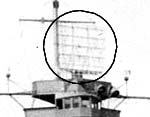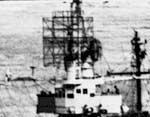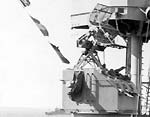-----1945年4月第90航空母舰分队历史
The first Kamikaze ("Divine Wind") attacks in October 1944 changed the nature and psychology of the Pacific war. The Kamikaze - a Japanese fighter or bomber, often armed with a single large bomb, carrying enough fuel for a one-way suicidal strike - was a lethal and fearsome weapon.
The Kamikaze, if he succeeded in penetrating a Task Force's cruiser and destroyer screen, was far more dangerous than an ordinary bomber or torpedo plane. Though usually flown by minimally trained pilots, Kamikazes were in a sense "smart" bombs, capable of waiting for the opportune moment to strike, and keeping up with every turn of their target. If they struck a ship - and 7% did - the disintegrating plane, burning fuel and plunging engine would inflict considerable damage beyond that caused by the bomb itself.
The Kamikaze attack symbolized a mindset incomprehensible to most Americans. For the most part, American commanders strove to minimize casualties in their forces: suicidal attacks were virtually unheard of. But the Kamikaze attack was suicidal, was ordered by commanding officers, was part of Japan's strategy. It went beyond what American seamen understood as "fair fighting": even in war. It disoriented, it terrified, it assaulted a man's hope that he might make it home alive.
In the face of this threat, and with Japanese naval air power in ruins, U.S. carrier forces had three primary roles: providing air support for ground forces and landings, providing air defense for the fleet, and suppressing Japan's ground-based air forces. As a night carrier, carrying Night Air Group 90, Enterprise was particularly involved in the latter two missions.
Along with other carriers designated as night carriers - the light carrier Independence CVL-22, and Saratoga CV-3 - Enterprise defended the fleet from night bomber attacks, flew daytime combat air patrols, and launched nighttime strikes against enemy shipping and airfields. It was dangerous and exhausting work. Joe Hranek, crewman in Enterprise's VT(N)-90 recalls: "...I was never sure where we were until [the pilot] cut the engine and the deck lights suddenly appeared. All in all it was sheer terror."
Enterprise's first strikes of 1945 were against airfields on Luzon, Philippines, followed by raids into Indo-China, and five major strikes on shipping and installations along the Indo-China and South China Sea coasts. Sailing north, she pounded Formosa (Taiwan) before returning to Ulithi atoll for replenishment. Departing Ulithi on January 26 she joined Task Force 58 on the mission her men had been waiting three long years for: . Dwarfing the Doolittle raid of April 1942, the February 16-17 strikes on Tokyo involved nearly 800 Navy fighters, bombers, and torpedo planes: blasting airfields, shipping and port facilities and industrial targets in and around Tokyo. Enterprise's Night Air Group 90 (NAG-90) flew into Tokyo Bay at dusk February 16, attacking the air base at Yokosuka, tearing up planes and airfields, radio and radar installations, trains and depots.

March 20, 1945: Aftermath of three near misses, and two friendly fire hits.
1945年3月20日在遭受攻击后的情景
Withdrawing south, Enterprise and the other carriers took up stations off , attacking nearby enemy airfields, and providing close air support for the Marines who landed on February 19.
If Allied victory seemed inevitable by this time, Iwo Jima, and later Okinawa, proved how Pyrrhic the victory could become. On Iwo Jima, 5931 Marines, 881 sailors and over 20,000 Japanese defenders died. Kamikaze attacks sank the escort carrier Bismarck Sea CVE-95, and knocked old Saratoga out of the war for good. Although most of TF 58's carriers pulled away from Iwo on February 23 for further strikes against Honshu, Japan, Enterprise's TG 58.5 remained behind. For a record-setting seven days and six hours between February 23 and March 2 - 174 hours total - Enterprise ran continuous air operations. Day and night, she provided air defense for the Marines on Iwo, the amphibious forces, and her own task group, and also struck at enemy airfields and shipping at Chichi Jima, to the north. Only severe weather forced the Big E to halt flight operations on March 2. The next day, round-the-clock operations resumed and continued until March 9, when Army Air Force planes flying from captured Iwo Jima airfields were able to relieve Night Air Group 90.
After two short days in Ulithi, Enterprise again sailed north, this time to pound airfields in Kyushu and Shikoku, in preparation for the Okinawa landings. On March 19, to the horror of every man in the fleet, the carrier Franklin CV-13 was struck by two bombs while her flight deck was full of armed and fueled planes. The resulting explosions and inferno killed 798 men. Remarkably, Franklin survived and eventually retired to the U.S. east coast for repair, but for her the war was over.
The next day, Enterprise herself came under attack. Throughout the day, enemy bombers and suicide planes had harassed the fleet, attacking singly or in small groups. Late in the afternoon, two 'Judy' bombers dove on the ship in separate attacks. The near misses caused no serious damage. However, in their determination to protect the Big E, other ships in her group had drawn down their anti-aircraft fire close to her flight deck. Moments after the second near miss exploded off Enterprise's starboard quarter, two 5" shells fired by another US Navy ship slammed into the Enterprise's 40mm gun tubs forward of the bridge, killing 7 and wounding 30. The spreading fires set off 20mm and 40mm shells in the gun tubs, and threatened the fueled and armed planes on the hangar deck below. After 20 minutes of fire-fighting efforts, hardly interrupted by another near miss off the port quarter, Enterprise's men had the fires under control, and 15 minutes later, out for good.
At Ulithi, men from repair ship Jason and Enterprise's R Division labored for ten days to patch up her wounds. On April 5, she sailed to join TF 58 off Okinawa, where the 3rd Marine Corps and XIV Army Corps had landed on April 1. On the 6th, as the Big E steamed northwest, 350 Kamikazes attacked TF 58, sinking three ships. Over the next six weeks, suicide attacks sank another 33 ships and damaged 368 others. On April 11, for the second time in less than a month, Enterprise was again attacked. Two Kamikazes crashed within yards of her, wrenching her hull, killing one, and wounding 18.
Again Enterprise withdrew to Ulithi for repairs by Jason's men: again, three weeks later, she returned to combat off Okinawa. On May 11, the Kamikazes returned, this time catching Admiral Marc Mitscher's flagship Bunker Hill CV-17 with a deckload of planes. Bunker Hill was still afire when Mitscher transferred his Flag to Enterprise. Striving to end the Kamikaze attacks - costing the Navy "a ship and a half a day," in Admiral Nimitz's words - on May 12 Enterprise launched a night strike against Kyushu, targeting air fields and port facilities.
Two days later, however, inbound Kamikazes once more began filling the fleet's radar screens shortly after sunrise. One of the planes penetrated the destroyer screen, hopping from cloud to cloud, carefully avoiding the anti-aircraft barrage and patrolling fighters. Shortly before 0700, the bomber dove on Enterprise, flipped over and plunged through Enterprise's flight deck just aft of the forward elevator. The explosion sent the 15 ton elevator rocketing 400 feet into the air, wounding 72 men and killing 12. Though the Big E never left her station or lost speed, her fighting efficiency was compromised, and on 16 May 1945, she withdrew from combat. The last carrier struck by a Kamikaze, she would not return to war.
Returning first to Pearl Harbor, she received a hero's welcome before sailing for "Uncle Sugar" - the United States - two days later, flying an enormous 578 ft pennant: one foot for every day since she'd left Bremerton in November 1943. Once again in Bremerton, she was repaired and overhauled: she was moored to Pier 6 in Puget Sound Navy Yard when Japan surrendered on 14 August 1945.

Enterprise pulls away from Southampton, England, on December 13, 1945.
1945年12月13离开英格兰南安普敦的“企业”号
Enterprise returned to Pearl Harbor in September, then sailed on September 25 with her new Night Air Group 55, bound for New York via the Panama Canal. This was the first of four "Magic Carpet" voyages she'd complete that fall and winter. From Pearl, she carried 1141 passengers, including hospital patients and repatriated prisoners of war.
She rejoined the fleet in New York Harbor October 17, for the Navy Day celebration on October 27. By this time, her story, and the crucial role she'd played again and again in the Pacific war, were public knowledge and for two weeks the Big E was the center of the city's attention. Her name was emblazoned across - "The Big E, Fightin'est Carrier, In!" Moored to Pier 26 on the Hudson River, she welcomed over a quarter million visitors, and rendered "passing honors" to President Truman when he inspected the ships at anchor on the 27th. That afternoon, Enterprise's Navy Band #51 led the World War II Victory Parade - and thousands of United States sailors, soldiers and Marines - down New York City's Avenue of the Americas. After nightfall, Night Air Group 55 flew in formation, fully alight, to salute the fleet and the Big E herself.
Recognition of her greatness did not end there. Tying up briefly in Southampton, England, on her November Magic Carpet voyage, Enterprise became the first - and to date only - ship outside the Royal Navy ever awarded that Navy's highest honor: the Admiralty Pennant. On that voyage, she carried 4668 servicemen home from Europe; on her next voyage, she carried another 4413 military passengers from Southampton, arriving in New York on . Her last Magic Carpet voyage took her to the Azores, where she picked up 3557 passengers, including 212 WACS, returning to New York January 17, 1946. The next day she moored at Bayonne, New Jersey: a proud ship, but never to sail under her own power again.
第一次自杀式(神风突击队)攻击发生在1944年10月。从此,太平洋战争的本质和双方士兵心理都发生了重大改变。自杀式飞机是日本由战斗机或者轰炸机改装的。通常这种飞机带一颗大的炸弹,油量只能单程飞行。不管怎么说这种飞机都是一种致命和可怕的武器。
一架自杀飞机如果成功地突破了特混舰队巡洋舰和驱逐舰的防空圈的话,它远比一架普通的轰炸机或者鱼雷机要危险。自杀飞机通常是由缺乏经验的飞行员驾驶,因此它某种意义上说是一种“灵巧炸弹”,而且它能够选择好的机会进行攻击,能够追踪目标的每一个动向。如果神风机击中了目标(成功率大约为7%),解体的飞机,燃烧的油料和飞散的引擎会造成损伤远比炸弹爆炸的威力大得多。
自杀攻击机是大部分美国是无法理解的。通常,美国指挥官会尽力减少己方的伤亡,事实上从未使用过自杀性的攻击。而在军官指挥下的自杀攻击神风突击队则是日本战略的一部分。这超过了美国水兵心目中的“公平战争”的承受能力。甚至在战争中,它使得一个人应该尽可能活着回家的希望变得迷惑、恐惧和渺茫。
面对这种威胁,同时还有日本海军已经基本毁灭的情况下,美军航母的任务成了以下三项:为地面和登陆部队提供空中掩护,为舰队提供空中防御,压制日本的陆航空兵。作为装载着第90夜航大队的夜航航母,“企业”号主要参与了后两项任务。
和其他被指定的夜航航母比如CVL-22轻型航母“独立”号和CV-3“萨拉托加”号一起,“企业”号主要为舰队提供对夜间轰炸机攻击防御,白天进行空中战斗巡逻,夜间攻击敌方船只和机场。这都是危险和疲劳的工作。“企业”号上的一个名为Joe Hranek成员回忆说“直到引擎关掉,甲板灯亮起,我都不知道我们到底在哪里。这一切完全是令人恐怖。”
1945年“企业”号的第一次任务是对吕宋岛上的机场进行攻击,然后是对印度支那半岛的袭击,接着沿着印度支那和南中国海的海岸线对船只和设施进行了五次较大的攻击。然后她在向北航行袭击了台湾岛后,“企业”号回到乌里锡环礁进行补给。1月26日,“企业”号驶离乌里锡环礁后加入第58特混舰队,他们要进行船员们已经盼望了三年的任务。这次空袭使得杜立特在1942年4月的空袭相形见拙。2月16日和17日,近800架海军战斗机,轰炸机和鱼雷机参加了对东京的空袭。它们轰炸了东京市内外的机场,船只,港口设施和工业设施等目标。“企业”号的第90夜间大队在2月16日黄昏飞入东京湾,攻击了横须贺的空军基地,摧毁了飞机,机场,无线电,雷达设备,火车和机库。
随后“ 企业”号和其他航母撤向南方,在硫黄岛外进入战备状态。它们攻击邻近的日本机场,并为2月19日登陆的海军陆战队提供空中支援。
在同盟国即将获得最终的胜利的时候,硫黄岛和后来的冲绳岛显示了胜利到来最终到来的时候是何等的艰难。在硫黄岛,5931名海军陆战队,881名水手,以及20000多名日本士兵丧生。神风突击队击沉了CVE-95护航航母“俾斯麦海”号,并且重伤了老“萨拉托加”号,使它永远退出了战场。虽然第58特混舰队的大部分航母在2月23日对本州岛进行进一步的袭击,“企业”号却被留了下来。作为一项记录,从2月23日到3月2日,“企业”号连续作战共达7天零6小时(共174小时)。它昼夜不停地掩护岛上的陆战队员,两栖部队和它自己所在编队,还要打击北方的小笠原群岛的机场和船只。直到3月2日,糟糕的天气才中止了大E的不知疲倦的起降作业。第二天,“企业”号不分昼夜的空中行动再次开始,直到3月9日,美国陆航航空队的飞机可以从被占领的硫黄岛的机场出发执行任务。第90夜航联队才得以停止任务。
在乌里锡环礁休息了两天后,“企业”号再次驶向北方。这次,它要袭击九州岛和四国岛上的机场,为对冲绳岛的登陆作准备。3月19日,发生了一件令舰队的每个人都感到恐怖的事情,当CV-13“富兰克林”号飞行甲板上停满了满载燃油和武器的飞机时,她被两颗炸弹击中。然后引发的大爆炸导致798人死亡。但是,“富兰克林”号奇迹般地存活了下来,并且最终驶回了美国东海岸进行修理,但它的战争也就此结束了。
第二天,“企业”号自己也遭到了攻击。整整一天,日本轰炸机和自杀飞机都以单机或小群骚扰着舰队。下午晚些时候,两架D4Y彗星飞机先后对“企业”号进行了俯冲攻击,但由于偏离目标并没有造成严重损伤。然而,为了保护大E,编队里的其它舰只的防空炮火角度压得很低以至于太靠近“企业”号的飞行甲板。在第二枚炸弹偏离目标在“企业”号右舷爆炸后不久,两颗其它舰只发射的5英寸防空炮弹射入了“企业”号舰桥前方的40毫米防空弹药库,导致7死30伤30。散布开来的火焰引燃了弹药库里的20毫米和40毫米炮弹,并且威胁到了下方飞行甲板上的加载了燃油和弹药的飞机。在20分钟的抢救后,期间还被一次对左舷的偏离目标的攻击打断,“企业”号的船员控制了火势,又过了15分钟,他们扑灭了大火。
在乌里锡环礁,修理船维修人员苦干了10天修补好了“加森”号和“企业”号的伤势。4月5日,“企业”号加入了在冲绳岛外的第58特混舰队。在那里第3海军陆战队军和陆军第14军已在4月1日登陆。4月6日,正当大E向西北方航行时,350架自杀飞机攻击了第58特混舰队,3艘军舰被击沉。在接下来的6个星期中,自杀飞机击沉了33艘舰船,击伤368艘。4月11日,不到一个月的时间里,“企业”号遭到第二次袭击。两架神风机坠毁在离它几码的地方,造成了船体扭曲,1人死亡,18人受伤。
“企业”号再一次返回乌里锡环礁由Jason号修理。三个星期后,它再次投入冲绳岛的战斗。5月11日,神风突击队又一次袭击舰队,这次海军上将马克.米契尔的旗舰CV-17“邦克山”号被击中了,当时“邦克山”号的甲板上停满了飞机。当米契尔上将将他的将旗转移到“企业”号上时,他的旗舰还在燃烧。为了中止神风突击队的攻击――尼米兹上将的话是“每天海军损失一艘半条船”――“企业”号在5月12日对九州岛的机场和设备进行了一次夜间空袭。
即使这样,两天之后的早上,舰队的雷达嫂米屏幕上又一次布满了来袭的神风突击队。一架飞机突破了驱逐舰的防护圈,在云间躲避着防空炮火和巡逻的战斗机。在快7:00的时候,这架自杀机向“企业”号俯冲,撞入前升降机后的飞行甲板。爆炸把15吨重的升降机抛到400英尺高的空中,并且造成了12人死亡,72人受伤。虽然大E并没有丧失动力和减速,但作战能力大大降低了。1945年5月16日,它退出战斗返航。作为最后一艘遭到神风机撞击的航母,她再也没有返回战场。
返回珍珠港时,她受到了英雄般的欢迎。两天后,“企业”号启程返回美国本土,一条578英尺长的巨大旗帜飘扬在“企业号”上:每一英尺都代表着1943年11月她离开布赖默顿的每一天。还是在布雷默顿船厂,“企业”号又进行了一次大修。当1945年8月14日日本投降的消息传来的时候,她正停泊在普吉特湾海军船厂的6号码头。
“企业”号在9月返回珍珠港。9月25日她载着新的第55夜航联队通过巴拿马运河驶向纽约。这是它在秋冬完成的四次“魔毯”航行中的第一次。她从珍珠港,载运了包括医院里的伤员和被解救的战俘在内的1141名乘客。
“企业”号在纽约于10月17日重新加入舰队,准备在27日参加海军节的庆典。到此时,“企业”号的故事和在太平洋战争中的关键作用已是人人皆知,整整两周里,大E都是整座城市关注的焦点,她的名字出现在报纸的头条:“企业”号,头号航母,进港!“企业”号停泊在哈德逊河第26码头接受了数百万人的参观并在27日接受了杜鲁门总统的检阅。在这天下午,“企业”号的海军第51军乐队引导了二战胜利大游行,数千名水手,水兵和陆战队员参加了纽约大街上的游行。夜幕降临后,夜航55联队开着全部航行灯列队向“企业”号致敬。
对它的表彰到此还未结束。在11月的“魔毯”行动中,“企业”号在英国南安普敦荣获了皇家海军历史上唯一一次颁发给外国军舰的最高荣誉――海军旗帜。此次航行,它从欧洲带着4668人回国。在下一次旅程中,它又从南安普敦带回4413名军人,回到纽约。最后一次“魔毯”航行是从亚速尔群岛带回了3557人,包括212名女性。这次她在1946年1月17日回到纽约。第二天,它在新泽西的巴永内港停泊。这艘骄傲的军舰再也没有参加过作战。




















